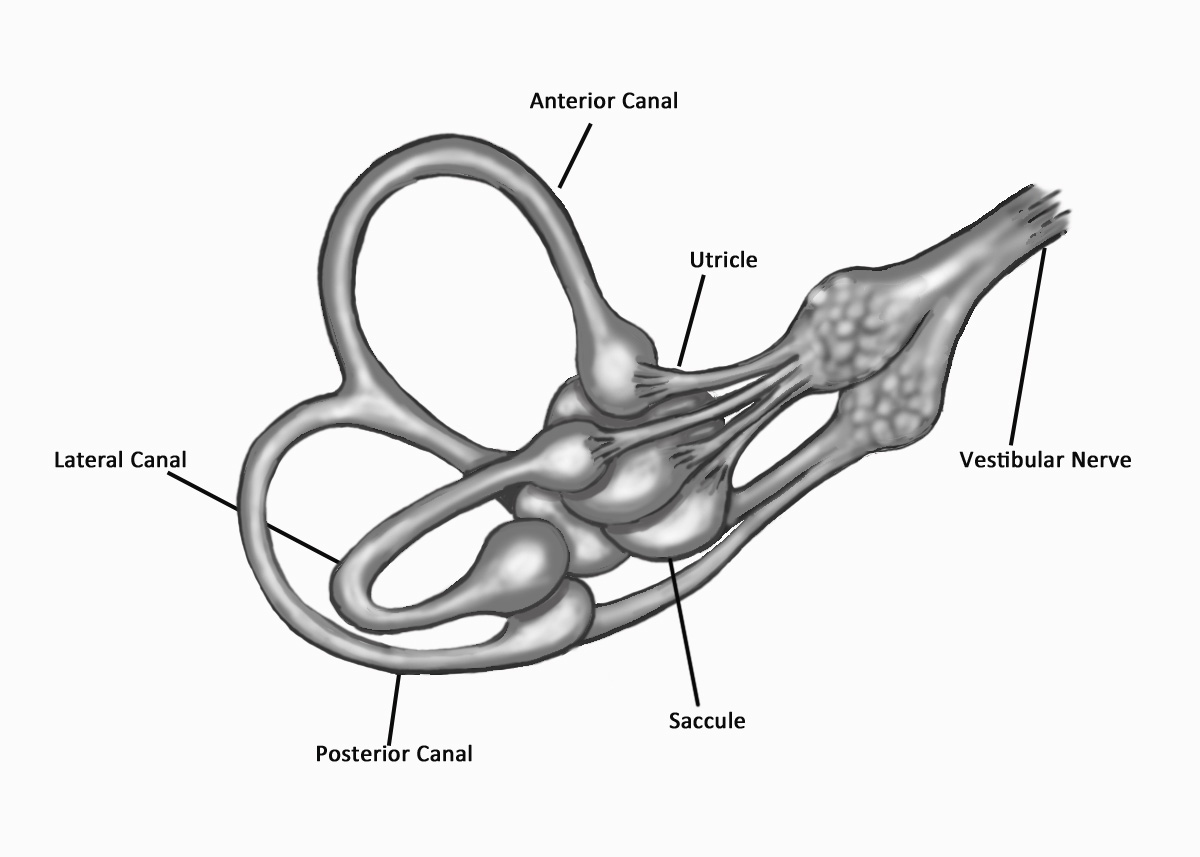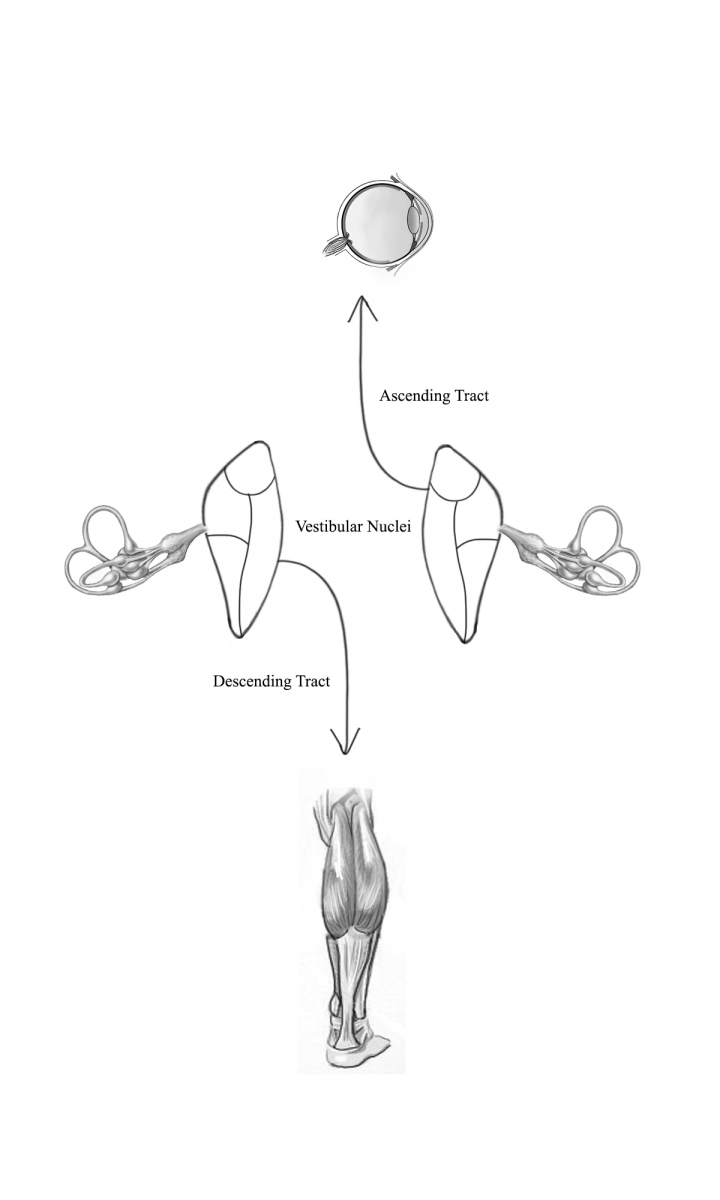
As a physical therapist, I’m often asked the following question by my patients, “Why am I dizzy?” Well, I can’t really answer that question without first explaining how the normal vestibular system works. So here goes!
Anatomy of the Ear
The ear is composed of three distinct regions (see Figure 1). The outer ear includes the pinna (the visible part of the ear), the tympanic membrane (the ear drum), and the external acoustic meatus (a canal that connects the visible part of the ear with the ear drum). The primary purpose of the outer ear is to transmit sound waves from the environment to the middle ear. The middle ear includes three small bones, the malleus (hammer), the incus (anvil), and the stapes (stirrup). The primary purpose of the middle ear is to transmit sound waves from the outer ear to the inner ear. Therefore, the outer ear and the middle ear are mainly involved with hearing. The inner ear includes a hearing apparatus (the cochlea) as well as a balance apparatus (part of the vestibular system). The two main components of the vestibular system are (1) the peripheral vestibular component and (2) the central vestibular component.
Peripheral Vestibular Component
 The peripheral vestibular component is composed of three semicircular canals, two otolithic organs, and cranial nerve VIII (see Figure 2). The three semicircular canals are the anterior canal, the lateral canal, and the posterior canal. The purpose of the semicircular canals is to detect rotational movements of the head. For example, the semicircular canals are activated when you turn your head left and right or when you tilt your head up and down. The semicircular canals are able to respond to rotational head movements in the following way. When a rotational head movement occurs, it causes the fluid in the semicircular canals to move. The movement of the fluid causes hair cells in the semicircular canals to bend, and the bending of the hair cells stimulates cranial nerve VIII. The two otolithic organs are the utricle and the saccule. The purpose of the otolithic organs is to detect linear movements of the head. For example, the otolithic organs are activated when you walk forward and backward or when you jump up and down. The otolithic organs are able to respond to linear head movements in the following way. When a linear head movement occurs, it causes the fluid in the otolithic organs to move but otoconia (calcium carbonate crystals or “ear rocks”) in the otolithic organs to lag behind. The lagging behind of the otoconia causes hair cells in the otolithic organs to bend, and the bending of the hair cells stimulates cranial nerve VIII. Cranial nerve VIII is comprised of the cochlear nerve (for hearing) and the vestibular nerve (for balance). The purpose of the vestibular nerve is to transmit balance-related information from the semicircular canals and the otolithic organs to the central nervous system.
The peripheral vestibular component is composed of three semicircular canals, two otolithic organs, and cranial nerve VIII (see Figure 2). The three semicircular canals are the anterior canal, the lateral canal, and the posterior canal. The purpose of the semicircular canals is to detect rotational movements of the head. For example, the semicircular canals are activated when you turn your head left and right or when you tilt your head up and down. The semicircular canals are able to respond to rotational head movements in the following way. When a rotational head movement occurs, it causes the fluid in the semicircular canals to move. The movement of the fluid causes hair cells in the semicircular canals to bend, and the bending of the hair cells stimulates cranial nerve VIII. The two otolithic organs are the utricle and the saccule. The purpose of the otolithic organs is to detect linear movements of the head. For example, the otolithic organs are activated when you walk forward and backward or when you jump up and down. The otolithic organs are able to respond to linear head movements in the following way. When a linear head movement occurs, it causes the fluid in the otolithic organs to move but otoconia (calcium carbonate crystals or “ear rocks”) in the otolithic organs to lag behind. The lagging behind of the otoconia causes hair cells in the otolithic organs to bend, and the bending of the hair cells stimulates cranial nerve VIII. Cranial nerve VIII is comprised of the cochlear nerve (for hearing) and the vestibular nerve (for balance). The purpose of the vestibular nerve is to transmit balance-related information from the semicircular canals and the otolithic organs to the central nervous system.
Central Nervous System
 The central nervous system is composed of the vestibular nuclei, the ascending tract, and the descending tract (see Figure 3). The purpose of the vestibular nuclei is to process the balance-related information from the peripheral vestibular system (along with visual information from the eyes and somatosensory information from the muscles). Once the vestibular nuclear complex has made sense of all of this incoming information, it transmits outgoing information along the ascending tract to control the movement of the eyes and along the descending tract to control the movement of the muscles. Therefore, the two primary functions of the vestibular system are to stabilize the eyes during movements of the head and to stabilize the body during movements of the head. The eyes are primarily stabilized through a mechanism known as the vestibulo-ocular reflex (VOR), and the body is primarily stabilized through a mechanism known as the vestibulo-spinal reflex (VSR). Here’s a simple way in which you can check the function of your own VOR. First, hold your hand 12 to 18 inches away from your face and look at the lines on the palm of your hand. With your head held still, quickly move your hand side to side. The lines on the palm of your hand should get blurry. Next, again hold your hand 12 to 18 inches away from your face and look at the lines on the palm of your hand. With your hand held still, quickly move your head side to side. The lines on the palm of your hand should remain visible. If your VOR is in working order, you will be able to stabilize your eyes while moving your head. Although the function of the VSR is not as straight-forward, you can check it by attempting to walk with head movements (do not try this by yourself if you have a balance-related disorder). If your VSR is in working order, you will be able to stabilize your body while moving your head.
The central nervous system is composed of the vestibular nuclei, the ascending tract, and the descending tract (see Figure 3). The purpose of the vestibular nuclei is to process the balance-related information from the peripheral vestibular system (along with visual information from the eyes and somatosensory information from the muscles). Once the vestibular nuclear complex has made sense of all of this incoming information, it transmits outgoing information along the ascending tract to control the movement of the eyes and along the descending tract to control the movement of the muscles. Therefore, the two primary functions of the vestibular system are to stabilize the eyes during movements of the head and to stabilize the body during movements of the head. The eyes are primarily stabilized through a mechanism known as the vestibulo-ocular reflex (VOR), and the body is primarily stabilized through a mechanism known as the vestibulo-spinal reflex (VSR). Here’s a simple way in which you can check the function of your own VOR. First, hold your hand 12 to 18 inches away from your face and look at the lines on the palm of your hand. With your head held still, quickly move your hand side to side. The lines on the palm of your hand should get blurry. Next, again hold your hand 12 to 18 inches away from your face and look at the lines on the palm of your hand. With your hand held still, quickly move your head side to side. The lines on the palm of your hand should remain visible. If your VOR is in working order, you will be able to stabilize your eyes while moving your head. Although the function of the VSR is not as straight-forward, you can check it by attempting to walk with head movements (do not try this by yourself if you have a balance-related disorder). If your VSR is in working order, you will be able to stabilize your body while moving your head.
Summary
The vestibular system processes balance-related, visual (from the eyes), and somatosensory (from the muscles) information. A normal vestibular system allows an individual to stabilize the eyes and the body during movements of the head. If the individual has a vestibular disorder, vision and/or balance may be affected.
 Author: Bonni Kinne, PT, MSPT, MA
Author: Bonni Kinne, PT, MSPT, MA